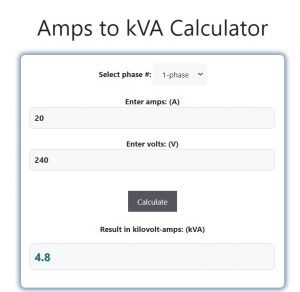About Amps to kVA Calculator (Formula)
In electrical systems, converting amperes (amps) to kilovolt-amperes (kVA) is essential for understanding the power consumption of devices and ensuring proper equipment sizing. Whether you’re working with single-phase or three-phase power, the Amps to kVA Calculator simplifies the conversion process, making it easier to manage your electrical systems effectively.
Formula
The formulas used in the Amps to kVA Calculator depend on whether you’re dealing with a single-phase or three-phase system:
- 1-Phase: The formula for converting amps to kVA in a single-phase system is: S (kVA) = I (A) × V (V) / 1000
- 3-Phase:
- Line to Line Voltage: The formula is: S (kVA) = √3 × I (A) × VL-L (V) / 1000
- Line to Neutral Voltage: The formula is: S (kVA) = 3 × I (A) × VL-N (V) / 1000
How to Use
Using the Amps to kVA Calculator is straightforward:
- Select your system type: Choose between single-phase and three-phase (line-to-line or line-to-neutral).
- Enter the current (amps): Input the current in amperes (A).
- Enter the voltage: Depending on your system, input the voltage (V) for either single-phase or the appropriate three-phase option.
- Calculate kVA: Click the “Calculate” button, and the calculator will provide the power in kilovolt-amperes (kVA).
Example
Let’s say you have a single-phase system with a current of 20 amps and a voltage of 240 volts. By entering these values into the calculator, you’ll find that the power is 4.8 kVA.
For a three-phase system, if you have a current of 30 amps with a line-to-line voltage of 400 volts, the power is calculated as 20.78 kVA.

FAQs
1. What is the difference between kVA and kW? kVA (kilovolt-amperes) is the apparent power, while kW (kilowatts) is the real power. kVA includes both active and reactive power, whereas kW only includes active power.
2. Why do I need to convert amps to kVA? Converting amps to kVA helps in sizing generators, transformers, and other electrical equipment to ensure they meet the power requirements of your system.
3. Can this calculator be used for both AC and DC systems? The Amps to kVA Calculator is designed for AC systems, particularly for single-phase and three-phase configurations.
4. How does power factor affect the kVA calculation? Power factor is not directly involved in the kVA calculation but is crucial when converting kVA to kW. A low power factor indicates more reactive power in the system.
5. What is a single-phase system? A single-phase system has one AC voltage waveform, typically used in residential and light commercial applications.
6. What is a three-phase system? A three-phase system has three AC voltage waveforms, commonly used in industrial and large commercial settings due to its efficiency in power distribution.
7. Can I convert kVA back to amps? Yes, you can convert kVA back to amps if you know the voltage and whether the system is single-phase or three-phase.
8. What is line-to-line voltage? Line-to-line voltage is the voltage between any two phases in a three-phase system.
9. What is line-to-neutral voltage? Line-to-neutral voltage is the voltage between any phase and the neutral point in a three-phase system.
10. Why is √3 used in the three-phase formula? The √3 factor accounts for the phase difference in a three-phase system, which affects the relationship between line-to-line and line-to-neutral voltages.
11. How accurate is the Amps to kVA Calculator? The calculator provides accurate results based on the inputs provided, assuming the system is balanced and operating under standard conditions.
12. Can this calculator be used for generator sizing? Yes, the calculator can help determine the required kVA for generator sizing based on the current and voltage of your system.
13. Does this calculator consider the power factor? No, this calculator does not consider power factor. Power factor is typically used when converting between kVA and kW.
14. What voltage should I use in the calculator? Use the nominal operating voltage of your system, which should match the voltage rating of the equipment in use.
15. How do I know if my system is single-phase or three-phase? Single-phase systems typically have two wires, while three-phase systems have three or four wires. Your electrical service type or equipment rating will indicate the system type.
16. Can I use this calculator for different voltage levels? Yes, you can use this calculator for any standard voltage level, as long as you correctly input the voltage and current values.
17. Is this calculator applicable to all countries? Yes, the calculator can be used globally, provided you enter the correct voltage and current values specific to your region’s electrical standards.
18. How do I handle unbalanced loads in a three-phase system? For unbalanced loads, it’s recommended to calculate the kVA for each phase separately and then sum the results for a more accurate total kVA.
19. Can I use the Amps to kVA Calculator for motor loads? Yes, this calculator is suitable for converting motor loads from amps to kVA, but make sure to account for any additional factors like efficiency and power factor.
20. What are common errors to avoid when using the calculator? Ensure you select the correct system type (single-phase or three-phase) and input the voltage and current accurately. Misidentifying these could lead to incorrect kVA calculations.
Conclusion
The Amps to kVA Calculator is a valuable tool for anyone working with electrical systems. Whether you’re sizing equipment or managing power distribution, this calculator simplifies the process of converting amps to kVA for both single-phase and three-phase systems. By understanding the formulas and using the calculator correctly, you can ensure your electrical setup is efficient and reliable.
